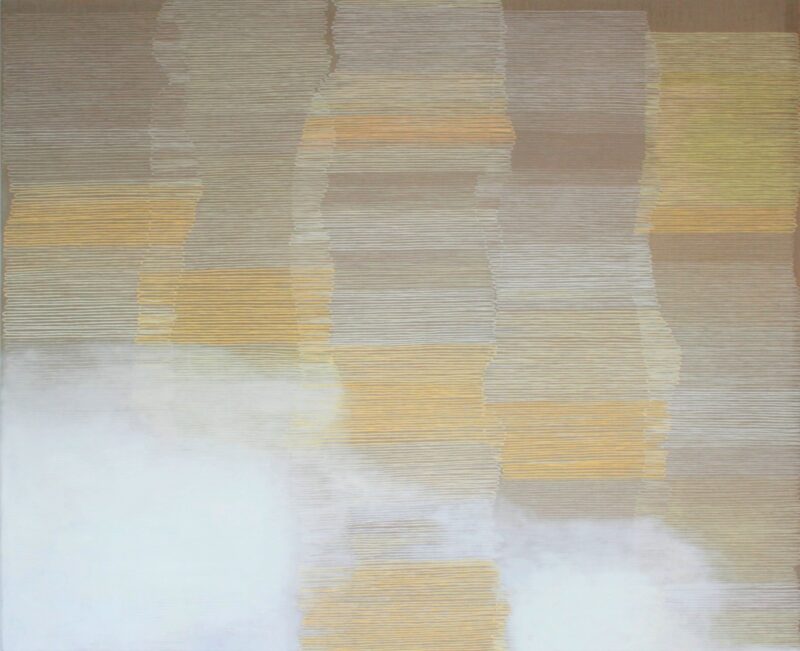
Trang T. Lê is a visual artist based in Southern California. Born in Nha Trang, South Vietnam, Lê, she resettled in San Francisco in 1982 with her family. As a survivor of war, Lê’s paintings reflect not violence but peace and tranquility—the natural yearning to heal the human heart burdened by a tumultuous past.
In a catalogue essay to accompany an exhibition of Le’s work, Jill Thayer writes:
A calm presence is felt upon viewing the paintings of Trang T. Lê. Her ethereal compositions impart the quiet essence of nature in a visual language of contemplation. For Lê, this meditative state reveals a healing source of life. For viewers, it’s a pause for reflection. Her methodology suggests nuances of Post-Impressionist, Expressionist, and Minimalist genres calling to mind the metaphysical auras of Rothko and aesthetic subtleties of Agnes Martin. Yet, Lê’s approach is uniquely her own.
As the Diasporic Vietnamese Artists Network launches a re-designed site for the new year, which includes artwork by Lê, we’re excited to present this conversation between the artist and DVAN founder Isabelle Thuy Pelaud.

TRANG T. LÊ: (looking at the DVAN website) Thank you. It is beautiful. We artists need you. We’re not good at promoting ourselves. We’re not good at being out there. And having you and DVAN, it’s wonderful. I’m very grateful.
ISABELLE THUY PELAUD: Oh no, we’re grateful. Thank you for allowing us to showcase your artworks on our new website. It makes it look beautiful.
I am looking at your website. On the home page, you write that you survived the war, and that your paintings reflect not violence but peace and tranquility—the natural yearning to heal the human heart burdened by a tumultuous past. Is this something you really think about when you do your artwork, or is this something you came about afterward?
TTL: Tranquility… With every painting, I go through struggle, difficulties. I work through them. And when I look at them, it’s just become meditative, the tranquility of it… No matter what state I am in, if I’m in a confusing state, or angry, or upset, somehow I work through it when I paint and it helps me heal.
ITP: Does the healing come from your choice of colors and shapes, the end result if you will, or is it more about the process, like by working very slowly, or just about being happy doing something you love?
TTL: It is about spending the time. It’s like when we meditate, we spend time. When I’m in my studio, I’m in a quiet space. The more I spend time with the painting, the more I go to that state of mind and feelings of being present. In my daily life, I struggle with things around me, but when I go into my studio and work, I feel that everything is going to be okay.
The choice of color is part of it. My paintings are not so busy, it has to do with my personality. So, the colors I use are monochromatic. It gives that feeling that colors are not fighting with each other. My relationship with colors reflects my personality, how I feel.
ITP: Yes, I can see this. It transcribes really well on the canvas. When I look at your artwork, I feel what you are feeling it seems. It is where the magic of art lies, the ability to put into the canvas exactly what is going on inside of you. It is the same thing with writing. It’s not easy to do that. Not too many people can.
TTL: Yes. With every painting, I struggle. I struggle with the composition and color, like how I struggle with life. As I am working on it, through it, I heal.
ITP: If I may ask, what do you feel you have to heal from?
TTL: Oh, so much. Life. Daily life, having to deal with things. It’s not easy. Life is a struggle. We all go through it, I think. Growing up, living in a country that’s at war; how are we supposed to heal from war? We have to heal ourself. And then, going through my marriage, having kids and then divorce. It’s hard. It’s painful. Then, there is the daily worrying of finance. Life, it’s just a series of ups and downs, ups and downs…
ITP: Yes. I hear you. There is something similar about us… People sometimes see art as just a creative expression; but for you, art has another function too. You believe that art has a power to heal.
TTL: Yes. Especially when I use a small brush; I sit and I paint, I use a small brush, and somehow, it calms me. And then, there is the surface. The surface of the canvas, and how the fabric bounces when I lay the brush on the canvas, I can feel the vibration, the gentleness of the brush touching that canvas somehow brings calmness.
ITP: I get it. And you have different phases too, right? Different colors. I remember when I first met you, you did a lot of work with white. White on white. It was extremely subtle. Now you have these vibrant blues and reds…
TTL: Yes. It was a white phase. I use white for healing. It’s light. It feels like when I wake up in the morning, it’s like a beginning of starting a new day, or starting a new chapter. I like that feeling a lot. Throughout my life, with different series, I always like to work with white.
It’s hard for me to work with dark color. I think during my divorce, I worked with darker color. And I remember my gallery agent said: “Trang, it’s all dark. This is going to be hard to sell.” But it reflected how I felt at the time. So, there’s no way I can run away from how I feel. My art has to do with my experience, with my life, my daily life.
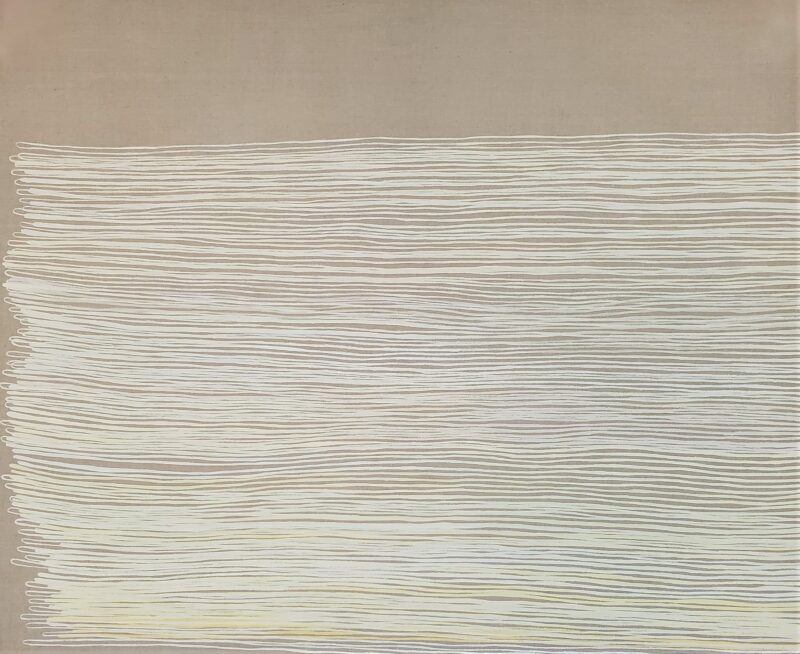
ITP: Yes. White and yellow are very healing colors. You have a lot of those colors. But what about that blue, that vibrant blue? In Daoism, blue is about the intellect, the mind.
TTL: Yes. For some reason, I always like to work with these colors: white, yellow, blue, and then some red. And then last year, I started to work with green. Because of the pandemic, I did a lot of walking. I found green very soothing and healing too. Nature helps us go through what we go through, too.
ITP: Yes, I agree. Green, like trees, is very generous. And so is the blue of water. And the combination of the white and blue create almost another color, another feeling. I love the combination of blue and white. Were you trained as an artist?
TTL: Yes, I went to Claremont University. I have a painting degree from there. I graduated in 2006. It’s a very good school.
ITP: It shows in your command of the brush and color. So now, you live off your artwork?
TTLwent through school, I invested in properties. Because I knew that being an artist, it’s not that easy to make a living. And at that time I didn’t think that teaching was something I would like to do, because I’d rather paint in my studio.
ITP: Nice
TTL: Yes. Because I love painting so much, I had to find something else that could help me make money; I also sell work.
ITP: Right. And selling your work with galleries?
TTL: Yes, galleries. I’m lucky that I have art dealers, they sell the work through commissioning too. They go to corporations and hotels, and they present my work along with other artists. So, it helps a lot.
ITP: Yes. One thing that I also really like about your work is that although it is in your experience as a survivor and war, it is not dark. This does not to mean that there is no suffering. But it seems like with your art, you point toward a direction. A few months ago, someone was asking DVAN to talk about joy. But your attachment is neither rooted in nostalgia nor in joy. It is more about peace, an inner peace, tranquility, calmness.
It reminds me of the Buddhist story of the lotus. The lotus root needing the mud in order to make the flower.
TTL: Yes.
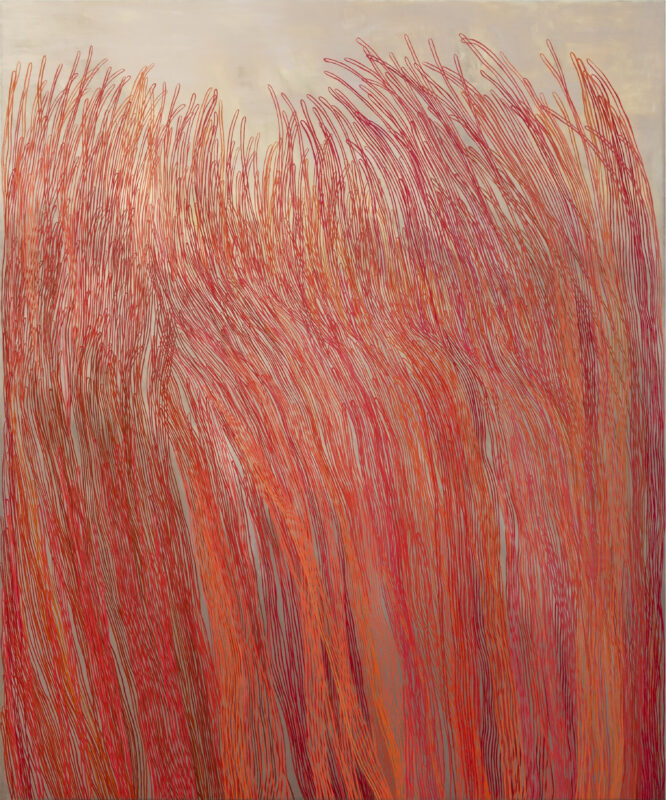
ITP: And if I hear you correctly, you are telling me that the root of your work is mud, but that you’ve worked through it to a point where you’ve arrived at a peaceful place; and that you recognize that it is peaceful because you know the mud, and once you grasp it for a moment, you can bring it to life through your colors, and your composition— your art. It’s very inspiring.
TTL: Thank you. The way you describe it, it’s very well put. We often do not want to face the problems we have. Because we don’t want to deal with them. Being an artist, it’s very hard to ignore them. We’re very in touch with our emotion and feelings. Sometimes, I want to forget them, but then working on a painting, it comes out, it shows. Subconsciously, I don’t really know how, but it shows. It always does.
I can’t run away from it. Like you say, it’s from and about the root. When I have a problem, I work through it, and somehow I find healing, and I learn from it.
ITP: You learn from it emotionally.
TTL: Yes, emotionally. When I face problems, I allow myself to feel, and that makes me heal. The most painful thing in my life is my divorce. Because being a mom, divorced, you’ve been with this person for 21 years, the children, and going through all the changes. It’s hard. I still go through things. I still have that pain here and there. The pain, the loss, the regret, all of that. But painting helps.
ITP: How long ago was this?
TTL: 2013. A year before that, I went to see you, I remember. I dropped off the painting to you for DVAN.
ITP: I know. I understand. How old are your children?
TTL: I have a daughter who is 14. And my two older ones are 22 and 23. What about you? How old are your kids?
ITP: I have one who is 27.
TTL: Oh, wow. You look so young.
ITP: Oh, you look young.
TTL: We’re both. We’re both.
ITP: Sorry you had to go through that. You didn’t deserve…
TTL: But it’s part of life. I think whatever we go through, it’s just part of life. I don’t find it as something bad. But when we love, we experience hurt.
ITP: It’s part of life…
TTL: Yes
ITP: Nothing is permanent.
TTL: You’re right. Nothing is permanent. Life is like a wave, with ups and downs, ups and downs, ups and downs.
ITP: So with your painting, you remove the waves. You’re imagining a world without waves.
TTL: My painting is not to remove myself from waves, but to flow with the waves. If there is a down moment going through the struggles with life, there will the up moment. Nothing is permanent, things will get better. Through being an artist, it helps heal me to see life as gentle waves. As the matter of fact, Meher McArthur wrote a beautiful book about my work called The Gentle Wave.
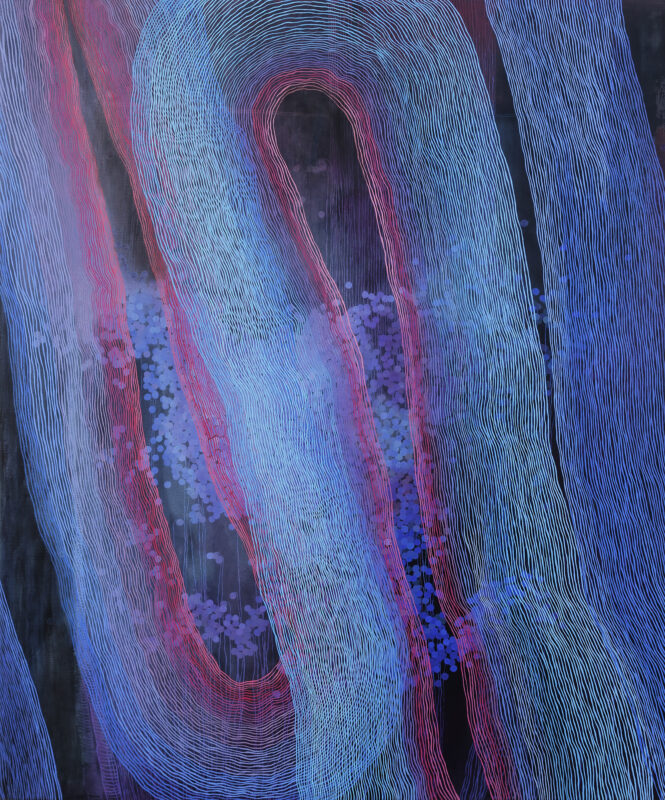
ITP: Oh, I will look for it. What’s your dream then? It seems like you have a dream life, because you do artwork full time already, right?
TTL: My dream is to just continue painting. I don’t ask for fame. When I first graduated from Claremont, when I got a review from a newspaper or something, I got so excited, so happy. Or when I sold a painting, I was really excited. But at this stage of my life, I find it a blessing just to paint every day. So my dream is to be able to paint until the day I leave Earth. Because it somehow helps me to be a better person, and understand about things, and about myself.
ITP: Yes. And you help the world with your vision. Because when I look at your paintings, I found them very calming. I love how they look and I love how I feel looking at them. I went through all the images of your artworks for the DVAN website. I’m really happy how they are now part of DVAN look and identity, because it also reflects what we are trying to do. It says something about our stories. Many of us come from mud. We come from a history that is muddy, difficult—so the question is what do we make from it? I am happy that your images and colors point to the directions of inner peace, tranquility, calmness. It feels right.
TTL: I think that’s the most happiness we can aspire to.
ITP: If we can all get there, stick together, help each other, talk with each other, hold hand instead of competing or gossiping behind each other’s back…Then maybe we’ll get there faster. That combination of blue and white colors…that’s success. It is a different path towards success, a different vision of success. If someone makes a lot of money, but deep inside there are a lot of waves, a lot of turmoil, then it is not success, right? Artists like you show a different path, and it’s really important.
TTL: Thank you. Yes, how we need to stick to each other to help and not hurt each other. But I think in order to help other, we need to have that inner peace. From that inner peace, we will stay away and not be part of the gossips and competitions which cause us to hurt each other. For me success is not about money but to have that inner peace; one hour to be in that state a day is great. It is important because it helps me find the balance. It is not easy but I get it through painting; people gravitate toward it. I think when we find that inner peace, people can feel it.
ITP: I know, I feel it. Maybe it is because when you do your art, you’re fully yourself. It’s very rare that people are really fully themselves. Even a minute a day. To have that at least an hour a day, it’s a gift to yourself which becomes a gift to others through both your art and your way of being.
TTL: Yes. I used to say “Oh, I want this piece to sell. I want to make a lot of money,” but not anymore. For me, it’s all about being able to paint, and accept, or being aware, or have that inner peace we are talking about; but somehow, because of the way I create paintings, I’m able to sell.
ITP: You can sell because it’s beautiful.

 Trang T. Lê is a Vietnamese-American female contemporary visual artist based in Southern California. Born in Nha Trang, South Vietnam, Lê escaped communist rule with her family to resettle in San Francisco in 1982. As a survivor of war, Lê’s paintings reflect not violence but peace and tranquility—the natural yearning to heal the human heart burdened by a tumultuous past.
Trang T. Lê is a Vietnamese-American female contemporary visual artist based in Southern California. Born in Nha Trang, South Vietnam, Lê escaped communist rule with her family to resettle in San Francisco in 1982. As a survivor of war, Lê’s paintings reflect not violence but peace and tranquility—the natural yearning to heal the human heart burdened by a tumultuous past.
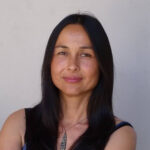 Isabelle Thuy Pelaud is Professor in Asian American Studies at San Francisco State University and co-Director of the Diasporic Vietnamese Artists Network (DVAN). She is the author of This Is All I Choose To Tell: History and Hybridity in Vietnamese American Literature (2011) and the co-editor of the award winning Troubling Borders: An Anthology of Art and Literature by Southeast Asian Women in the Diaspora (2014).
Isabelle Thuy Pelaud is Professor in Asian American Studies at San Francisco State University and co-Director of the Diasporic Vietnamese Artists Network (DVAN). She is the author of This Is All I Choose To Tell: History and Hybridity in Vietnamese American Literature (2011) and the co-editor of the award winning Troubling Borders: An Anthology of Art and Literature by Southeast Asian Women in the Diaspora (2014).


